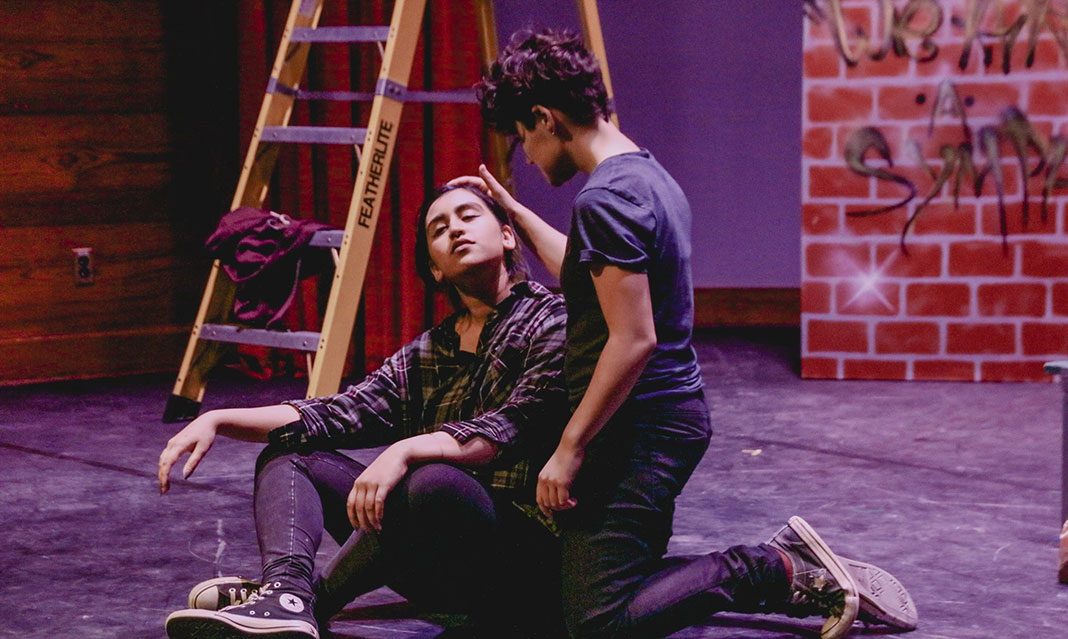Quite often there are youth who find themselves in dire situations, out on the streets with no home to turn to. Behind every faceless youth, shrouded by statistics, there’s an individual with their own story.
The Trinity College Drama Society showcased Polaroid Stories last week at the George Ignatieff Theatre. Written by Naomi Iizuka, the play acknowledges the experience of underprivileged adolescents living on the streets. It sends the message that the lives of young men and women facing homelessness are lives worth knowing and sharing. Iizuka interviewed real people and crafted her script using real stories.
The set by Shay Santaiti consisted of a bench and a large, fenced cage in the middle of the stage, surrounded by walls covered in graffiti, and a ladder. Paired with the warm yellow (and occasionally psychedelic) lights designed by Thomas Lynch and music by Henry Paterson, the set became an eerie place.
The play recounts the stories of 10 different people in unique situations. The stories included drug abuse, unhealthy relationships, prostitution, and more. Polaroid Stories functions as an adaptation of Ovid’s “Metamorphoses,” an extended poem that recounts the world’s history by incorporating Greek mythology. The segments of Polaroid Stories included stories by D (Ezera Beyene), Philomel (Mirabella Sundar Singh), Eurydice (Marium Raja), Persephone (Andrea Castaneda), Orpheus (River Pereira), Narcissus (Jonathan Dick), Echo (Claire Shenstone-Harris), G or Zeus or Hades (Marium Masood), SKINHEADboy or Theseus (Louis-Alexandre Boulet), and SKINHEADgirl or Ariadne (Katarina Prystay).
Many of the characters’ names come from Greek mythology. For example, Persephone is the goddess of the harvest, and Narcissus is a boy in love with his own reflection. In the play, each personality represents a different character in Greek folklore. Unfortunately, this was an element of the play that was unclear to the audience, because people were rarely, if ever, called by their name.
Ultimately, the play led to a great deal of confusion. The stories of the characters were separated into five different subplots, each taking turns on the centre stage. In the beginning, the actors made great use of the space by coming up and down the stairs to say their names. However, none of the names spoken in this scene were the names of their actual characters, making it hard to understand who they were referring to. Many stories beat around the bush, creating more questions than they answered. Plays should include nuance and subtext, but not to the point where no one knows what‘s happening. Due to the nature of the play’s structure, there were many ideas that were touched on but never expanded, and relationships that came out of nowhere. These features made the play generally hard to follow.
Of the five different plots that were explored, the story of SKINHEADboy and SKINHEADgirl was the most intriguing. It was easy to follow and invest in; it acted as a shining light for the play. The performance by Boulet was stunning. His makeup—done by Grace Manalili—made him look gaunt and almost frightening. It was easy to see that he invested his full effort into the role of SKINHEADboy. He gave amazing monologues, questioned God and monsters, and he recounted his life story. Every second of his performance was touching and lifelike. His relationship with SKINHEADgirl had more chemistry than all of the other characters. Together, they were a joy to watch. Prystay also gave a wonderful performance. She performed a monologue paired with a contemporary dance routine with Dick. Their performance was breathtaking.
Although the play was confusing overall, it had some astounding moments. All proceeds from ticket sales went to Eva’s Initiatives with Homeless Youth, SKETCH, and Sanctuary Toronto.
Polaroid Stories ran at the George Ignatieff Theatre until November 26.




The director’s name was Melissa Anne Fearon. I”m sorry to have left that out, I will remember for next time.